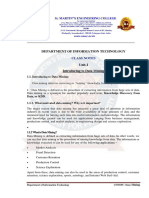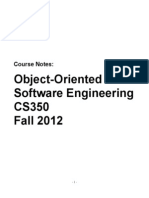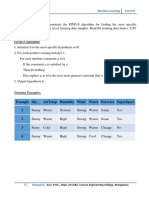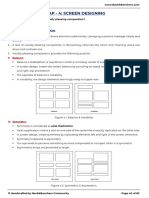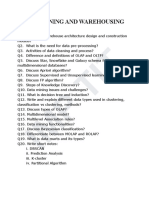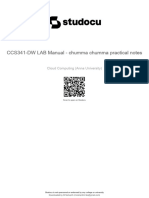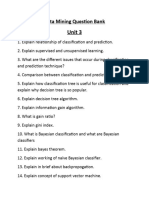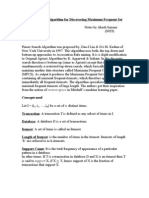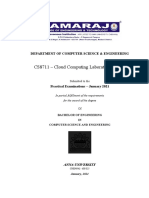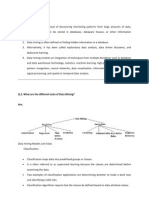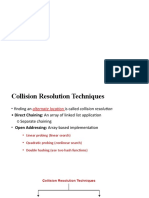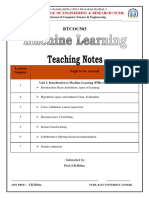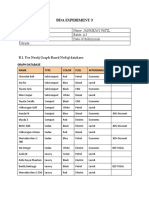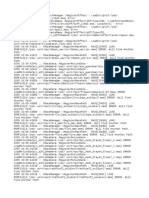Data Mining
IS698 Min Song
�Introduction
Motivation: Why data mining? What is data mining? Data Mining: On what kind of data? Data mining functionality Are all the patterns interesting? Classification of data mining systems Data Mining Task Primitives
Integration of data mining system with a DB and DW System
Major issues in data mining
2
�Why Data Mining?
The Explosive Growth of Data
Data collection and data availability
Automated data collection tools, database systems, Web, computerized society Major sources of abundant data Business: Web, e-commerce, transactions, stocks, Science: Remote sensing, bioinformatics, scientific simulation,
Society and everyone: news, digital cameras,
We are drowning in data, but starving for knowledge! Necessity is the mother of inventionData miningAutomated analysis of massive data sets
3
�Evolution of Database Technology
1960s: Data collection, database creation, IMS and network DBMS Relational data model, relational DBMS implementation RDBMS, advanced data models (extended-relational, OO, deductive, etc.) 1970s: 1980s:
Application-oriented DBMS (spatial, scientific, engineering, etc.)
Data mining, data warehousing, multimedia databases, and Web databases
1990s:
2000s
Stream data management and mining
Data mining and its applications Web technology (XML, data integration) and global information systems
4
�What Is Data Mining?
Data mining (knowledge discovery from data) Extraction of interesting (non-trivial, implicit, previously unknown and potentially useful) patterns or knowledge from huge amount of data Data mining: a misnomer? Knowledge discovery (mining) in databases (KDD), knowledge extraction, data/pattern analysis, data archeology, data dredging, information harvesting, business intelligence, etc. Simple search and query processing (Deductive) expert systems
5
Alternative names
Watch out: Is everything data mining?
�Why Data Mining?Potential Applications
Data analysis and decision support Market analysis and management
Target marketing, customer relationship management (CRM), market basket analysis, cross selling, market segmentation
Risk analysis and management
Forecasting, customer retention, improved underwriting, quality control, competitive analysis
Fraud detection and detection of unusual patterns (outliers) Other Applications
Text mining (news group, email, documents) and Web mining
Stream data mining Bioinformatics and bio-data analysis
6
�Ex. 1: Market Analysis and Management
Where does the data come from?Credit card transactions, loyalty cards, discount coupons, customer complaint calls, plus (public) lifestyle studies Target marketing Find clusters of model customers who share the same characteristics: interest, income level, spending habits, etc., Determine customer purchasing patterns over time
Cross-market analysisFind associations/co-relations between product sales, & predict based on such association Customer profilingWhat types of customers buy what products (clustering or classification) Customer requirement analysis Identify the best products for different customers
Predict what factors will attract new customers
Multidimensional summary reports Statistical summary information (data central tendency and variation)
7
Provision of summary information
�Ex. 2: Corporate Analysis & Risk Management
Finance planning and asset evaluation
cash flow analysis and prediction
contingent claim analysis to evaluate assets cross-sectional and time series analysis (financial-ratio, trend analysis, etc.)
Resource planning summarize and compare the resources and spending monitor competitors and market directions group customers into classes and a class-based pricing procedure set pricing strategy in a highly competitive market
8
Competition
�Ex. 3: Fraud Detection & Mining Unusual Patterns
Approaches: Clustering & model construction for frauds, outlier analysis
Applications: Health care, retail, credit card service, telecomm.
Auto insurance: ring of collisions Money laundering: suspicious monetary transactions Medical insurance Professional patients, ring of doctors, and ring of references
Unnecessary or correlated screening tests
Phone call model: destination of the call, duration, time of day or week. Analyze patterns that deviate from an expected norm Analysts estimate that 38% of retail shrink is due to dishonest employees
Telecommunications: phone-call fraud
Retail industry
Anti-terrorism
9
�Knowledge Discovery (KDD) Process
Data miningcore of knowledge discovery process
Task-relevant Data Data Warehouse Selection Pattern Evaluation
Data Mining
Data Cleaning
Data Integration Databases
10
�KDD Process: Several Key Steps
Learning the application domain relevant prior knowledge and goals of application Creating a target data set: data selection Data cleaning and preprocessing: (may take 60% of effort!) Data reduction and transformation Find useful features, dimensionality/variable reduction, invariant representation summarization, classification, regression, association, clustering
Choosing functions of data mining
Choosing the mining algorithm(s)
Data mining: search for patterns of interest
Pattern evaluation and knowledge presentation visualization, transformation, removing redundant patterns, etc.
Use of discovered knowledge
11
�Data Mining and Business Intelligence
Increasing potential to support business decisions
Decision Making
Data Presentation Visualization Techniques Data Mining Information Discovery
End User
Business Analyst Data Analyst
Data Exploration Statistical Summary, Querying, and Reporting Data Preprocessing/Integration, Data Warehouses Data Sources Paper, Files, Web documents, Scientific experiments, Database Systems
DBA
12
�Data Mining: Confluence of Multiple Disciplines
Database Technology
Statistics
Machine Learning
Pattern Recognition
Data Mining
Visualization
Algorithm
Other Disciplines
13
�Why Not Traditional Data Analysis?
Tremendous amount of data Algorithms must be highly scalable to handle such as tera-bytes of data Micro-array may have tens of thousands of dimensions
High-dimensionality of data High complexity of data
Data streams and sensor data
Time-series data, temporal data, sequence data Structure data, graphs, social networks and multi-linked data Heterogeneous databases and legacy databases
Spatial, spatiotemporal, multimedia, text and Web data
Software programs, scientific simulations
New and sophisticated applications
14
�Multi-Dimensional View of Data Mining
Data to be mined Relational, data warehouse, transactional, stream, objectoriented/relational, active, spatial, time-series, text, multi-media, heterogeneous, legacy, WWW Characterization, discrimination, association, classification, clustering, trend/deviation, outlier analysis, etc.
Knowledge to be mined
Multiple/integrated functions and mining at multiple levels
Database-oriented, data warehouse (OLAP), machine learning, statistics, visualization, etc. Retail, telecommunication, banking, fraud analysis, bio-data mining, stock market analysis, text mining, Web mining, etc.
Techniques utilized
Applications adapted
15
�Data Mining: Classification Schemes
General functionality Descriptive data mining Predictive data mining Different views lead to different classifications Data view: Kinds of data to be mined Knowledge view: Kinds of knowledge to be discovered
Method view: Kinds of techniques utilized
Application view: Kinds of applications adapted
16
�Data Mining: On What Kinds of Data?
Database-oriented data sets and applications
Relational database, data warehouse, transactional database
Data streams and sensor data Time-series data, temporal data, sequence data (incl. bio-sequences)
Advanced data sets and advanced applications
Structure data, graphs, social networks and multi-linked data
Object-relational databases Heterogeneous databases and legacy databases Spatial data and spatiotemporal data
Multimedia database
Text databases The World-Wide Web
17
�Data Mining Functionalities
Multidimensional concept description: Characterization and discrimination Generalize, summarize, and contrast data characteristics, e.g., dry vs. wet regions
Frequent patterns, association, correlation vs. causality
Diaper Beer [0.5%, 75%] (Correlation or causality?)
Construct models (functions) that describe and distinguish classes or concepts for future prediction
Classification and prediction
E.g., classify countries based on (climate), or classify cars based on (gas mileage)
Predict some unknown or missing numerical values
18
�Data Mining Functionalities (2)
Cluster analysis Class label is unknown: Group data to form new classes, e.g., cluster houses to find distribution patterns Maximizing intra-class similarity & minimizing interclass similarity Outlier analysis Outlier: Data object that does not comply with the general behavior of the data Noise or exception? Useful in fraud detection, rare events analysis Trend and evolution analysis Trend and deviation: e.g., regression analysis Periodicity analysis Similarity-based analysis Other pattern-directed or statistical analyses
19
�Are All the Discovered Patterns Interesting?
Data mining may generate thousands of patterns: Not all of them are
interesting
Suggested approach: Human-centered, query-based, focused mining A pattern is interesting if it is easily understood by humans, valid on Interestingness measures
new or test data with some degree of certainty, potentially useful,
novel, or validates some hypothesis that a user seeks to confirm Objective vs. subjective interestingness measures Objective: based on statistics and structures of patterns, e.g.,
support, confidence, etc.
Subjective: based on users belief in the data, e.g., unexpectedness, novelty, actionability, etc.
20
�Find All and Only Interesting Patterns?
Find all the interesting patterns: Completeness
Can a data mining system find all the interesting patterns? Do we need to find all of the interesting patterns?
Heuristic vs. exhaustive search Association vs. classification vs. clustering Can a data mining system find only the interesting patterns? Approaches First general all the patterns and then filter out the uninteresting ones Generate only the interesting patternsmining query optimization
21
Search for only interesting patterns: An optimization problem
�Why Data Mining Query Language?
Automated vs. query-driven?
Finding all the patterns autonomously in a database?unrealistic because the patterns could be too many but uninteresting
User directs what to be mined
Data mining should be an interactive process
Users must be provided with a set of primitives to be used to communicate with the data mining system
Incorporating these primitives in a data mining query language More flexible user interaction Foundation for design of graphical user interface Standardization of data mining industry and practice
22
�DMQLA Data Mining Query Language
Motivation A DMQL can provide the ability to support ad-hoc and interactive data mining By providing a standardized language like SQL Hope to achieve a similar effect like that SQL has on relational database Foundation for system development and evolution
Facilitate information exchange, technology transfer, commercialization and wide acceptance
23
�An Example Query in DMQL
24
�Integration of Data Mining and Data Warehousing
Data mining systems, DBMS, Data warehouse systems coupling
No coupling, loose-coupling, semi-tight-coupling, tight-coupling
On-line analytical mining data integration of mining and OLAP technologies
Interactive mining multi-level knowledge Necessity of mining knowledge and patterns at different levels of abstraction by drilling/rolling, pivoting, slicing/dicing, etc.
Integration of multiple mining functions Characterized classification, first clustering and then association
25
�Coupling Data Mining with DB/DW Systems
No couplingflat file processing, not recommended
Loose coupling
Fetching data from DB/DW Provide efficient implement a few data mining primitives in a DB/DW system, e.g., sorting, indexing, aggregation, histogram analysis, multiway join, precomputation of some stat functions Semi-tight couplingenhanced DM performance
Tight couplingA uniform information processing environment
DM is smoothly integrated into a DB/DW system, mining query is optimized based on mining query, indexing, query processing methods, etc.
26
�Architecture: Typical Data Mining System
Graphical User Interface Pattern Evaluation Data Mining Engine Database or Data Warehouse Server
data cleaning, integration, and selection Knowl edgeBase
Database
Data World-Wide Other Info Repositories Warehouse Web
27
�Major Issues in Data Mining
Mining methodology Mining different kinds of knowledge from diverse data types, e.g., bio, stream, Web Performance: efficiency, effectiveness, and scalability Pattern evaluation: the interestingness problem Incorporation of background knowledge Handling noise and incomplete data
Parallel, distributed and incremental mining methods
Integration of the discovered knowledge with existing one: knowledge fusion User interaction Data mining query languages and ad-hoc mining
Expression and visualization of data mining results
Interactive mining of knowledge at multiple levels of abstraction
Applications and social impacts Domain-specific data mining & invisible data mining Protection of data security, integrity, and privacy
28
�What Is Association Rule Mining?
Frequent patterns: patterns (set of items, sequence, etc.) that occur frequently in a database [AIS93] Frequent pattern mining: finding regularities in data
What products were often purchased together? Beer and diapers?! What are the subsequent purchases after buying a car? Can we automatically profile customers?
29
�Basics
Itemset: a set of items
E.g., acm={a, c, m}
Transaction database TDB
TID
100
Support of itemsets
Sup(acm)=3
Items bought
f, a, c, d, g, I, m, p a, b, c, f, l,m, o b, f, h, j, o b, c, k, s, p a, f, c, e, l, p, m, n
200 Given min_sup=3, 300 acm is a frequent 400 pattern 500 Frequent pattern mining: find all frequent patterns in a database
30
�Frequent Pattern Mining Methods
Apriori and its variations/improvements Mining frequent-patterns without candidate generation Mining max-patterns and closed itemsets Mining multi-dimensional, multi-level frequent patterns with flexible support constraints Interestingness: correlation and causality
31
�Apriori: Candidate Generation-and-test
Any subset of a frequent itemset must be also frequent an anti-monotone property
A transaction containing {beer, diaper, nuts} also contains {beer, diaper} {beer, diaper, nuts} is frequent {beer, diaper} must also be frequent
No superset of any infrequent itemset should be generated or tested
Many item combinations can be pruned
32
�Apriori-based Mining
Generate length (k+1) candidate itemsets from length k frequent itemsets, and Test the candidates against DB
33
�Apriori Algorithm
A level-wise, candidate-generation-and-test approach (Agrawal & Srikant 1994)
Data base D
TID 10 20 30 40 Items a, c, d b, c, e a, b, c, e b, e
1-candidates
Scan D
Itemset a b c d e Sup 2 3 3 1 3
Freq 1-itemsets
Itemset a b c e Sup 2 3 3 3
2-candidates
Itemset ab ac ae bc be ce
Min_sup=2 3-candidates
Scan D
Itemset bce
Freq 2-itemsets
Itemset ac bc be ce Sup 2 2 3 2
Counting
Itemset ab ac ae bc be ce Sup 1 2 1 2 3 2
Scan D
Freq 3-itemsets
Itemset bce Sup 2
34
�The Apriori Algorithm
Ck: Candidate itemset of size k Lk : frequent itemset of size k L1 = {frequent items}; for (k = 1; Lk !=; k++) do
return k Lk;
Ck+1 = candidates generated from Lk; for each transaction t in database do increment the count of all candidates in Ck+1 that are contained in t Lk+1 = candidates in Ck+1 with min_support
35
�Important Details of Apriori
How to generate candidates?
Step 1: self-joining Lk Step 2: pruning
How to count supports of candidates?
36
�How to Generate Candidates?
Suppose the items in Lk-1 are listed in an order Step 1: self-join Lk-1
Step 2: pruning
INSERT INTO Ck SELECT p.item1, p.item2, , p.itemk-1, q.itemk-1 FROM Lk-1 p, Lk-1 q WHERE p.item1=q.item1, , p.itemk-2=q.itemk-2, p.itemk-1 < q.itemk-1
For each itemset c in Ck do For each (k-1)-subsets s of c do if (s is not in Lk-1) then delete c from Ck
37
�Example of Candidate-generation
L3={abc, abd, acd, ace, bcd} Self-joining: L3*L3
abcd from abc and abd acde from acd and ace
Pruning:
acde is removed because ade is not in L3
C4={abcd}
38
�How to Count Supports of Candidates?
Why counting supports of candidates a problem?
The total number of candidates can be very huge One transaction may contain many candidates
Method:
Candidate itemsets are stored in a hash-tree Leaf node of hash-tree contains a list of itemsets and counts Interior node contains a hash table Subset function: finds all the candidates contained in a transaction
39
�Challenges of Frequent Pattern Mining
Challenges
Multiple scans of transaction database Huge number of candidates Tedious workload of support counting for candidates
Improving Apriori: general ideas
Reduce number of transaction database scans Shrink number of candidates Facilitate support counting of candidates
40
�Summary
Data mining: Discovering interesting patterns from large amounts of data A natural evolution of database technology, in great demand, with wide applications A KDD process includes data cleaning, data integration, data selection, transformation, data mining, pattern evaluation, and knowledge presentation Mining can be performed in a variety of information repositories Data mining functionalities: characterization, discrimination, association, classification, clustering, outlier and trend analysis, etc. Data mining systems and architectures Major issues in data mining
41
�A Brief History of Data Mining Society
1989 IJCAI Workshop on Knowledge Discovery in Databases
Knowledge Discovery in Databases (G. Piatetsky-Shapiro and W. Frawley, 1991)
Advances in Knowledge Discovery and Data Mining (U. Fayyad, G. Piatetsky-Shapiro, P. Smyth, and R. Uthurusamy, 1996)
1991-1994 Workshops on Knowledge Discovery in Databases
1995-1998 International Conferences on Knowledge Discovery in Databases and Data Mining (KDD95-98) Journal of Data Mining and Knowledge Discovery (1997) ACM SIGKDD conferences since 1998 and SIGKDD Explorations
More conferences on data mining
PAKDD (1997), PKDD (1997), SIAM-Data Mining (2001), (IEEE) ICDM (2001), etc.
42
ACM Transactions on KDD starting in 2007
�Conferences and Journals on Data Mining
KDD Conferences ACM SIGKDD Int. Conf. on Knowledge Discovery in Databases and Data Mining (KDD) SIAM Data Mining Conf. (SDM) (IEEE) Int. Conf. on Data Mining (ICDM) Conf. on Principles and practices of Knowledge Discovery and Data Mining (PKDD) Pacific-Asia Conf. on Knowledge Discovery and Data Mining (PAKDD) Other related conferences ACM SIGMOD VLDB (IEEE) ICDE WWW, SIGIR ICML, CVPR, NIPS
Journals
Data Mining and Knowledge Discovery (DAMI or DMKD)
IEEE Trans. On Knowledge and Data Eng. (TKDE) KDD Explorations
ACM Trans. on KDD
43
�Where to Find References? DBLP, CiteSeer, Google
Data mining and KDD (SIGKDD: CDROM) Conferences: ACM-SIGKDD, IEEE-ICDM, SIAM-DM, PKDD, PAKDD, etc. Journal: Data Mining and Knowledge Discovery, KDD Explorations, ACM TKDD Database systems (SIGMOD: ACM SIGMOD AnthologyCD ROM) Conferences: ACM-SIGMOD, ACM-PODS, VLDB, IEEE-ICDE, EDBT, ICDT, DASFAA Journals: IEEE-TKDE, ACM-TODS/TOIS, JIIS, J. ACM, VLDB J., Info. Sys., etc. AI & Machine Learning Conferences: Machine learning (ML), AAAI, IJCAI, COLT (Learning Theory), CVPR, NIPS, etc. Journals: Machine Learning, Artificial Intelligence, Knowledge and Information Systems, IEEE-PAMI, etc. Web and IR Conferences: SIGIR, WWW, CIKM, etc. Journals: WWW: Internet and Web Information Systems, Statistics Conferences: Joint Stat. Meeting, etc. Journals: Annals of statistics, etc. Visualization Conference proceedings: CHI, ACM-SIGGraph, etc. Journals: IEEE Trans. visualization and computer graphics, etc. 44
�Recommended Reference Books
S. Chakrabarti. Mining the Web: Statistical Analysis of Hypertex and Semi-Structured Data. Morgan Kaufmann, 2002 R. O. Duda, P. E. Hart, and D. G. Stork, Pattern Classification, 2ed., Wiley-Interscience, 2000 T. Dasu and T. Johnson. Exploratory Data Mining and Data Cleaning. John Wiley & Sons, 2003 U. M. Fayyad, G. Piatetsky-Shapiro, P. Smyth, and R. Uthurusamy. Advances in Knowledge Discovery and Data Mining. AAAI/MIT Press, 1996 U. Fayyad, G. Grinstein, and A. Wierse, Information Visualization in Data Mining and Knowledge Discovery, Morgan Kaufmann, 2001 J. Han and M. Kamber. Data Mining: Concepts and Techniques. Morgan Kaufmann, 2nd ed., 2006 D. J. Hand, H. Mannila, and P. Smyth, Principles of Data Mining, MIT Press, 2001 T. Hastie, R. Tibshirani, and J. Friedman, The Elements of Statistical Learning: Data Mining, Inference, and Prediction, Springer-Verlag, 2001
T. M. Mitchell, Machine Learning, McGraw Hill, 1997
G. Piatetsky-Shapiro and W. J. Frawley. Knowledge Discovery in Databases. AAAI/MIT Press, 1991 P.-N. Tan, M. Steinbach and V. Kumar, Introduction to Data Mining, Wiley, 2005 S. M. Weiss and N. Indurkhya, Predictive Data Mining, Morgan Kaufmann, 1998 I. H. Witten and E. Frank, Data Mining: Practical Machine Learning Tools and Techniques 45 with Java Implementations, Morgan Kaufmann, 2nd ed. 2005
